
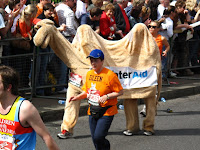





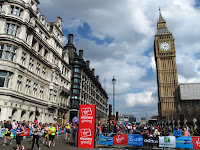



Murray & Christine's record of their journey. "A day in a car in an English county is a trip to a fairy museum where all the exhibits are live and real." Rudyard Kipling
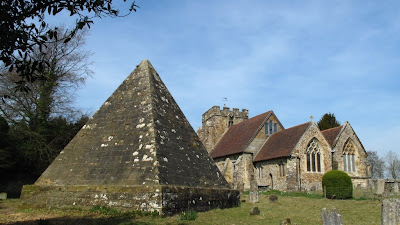
 Mad Jack may have been unfairly labelled, he was a wealthy Victorian, who inherited a fortune made in the iron industry. He is remembered for the six follies he commissioned but equally, it is suggested, he was providing work for local men who lost their jobs due to the decline in the Wealdon iron industry.
Mad Jack may have been unfairly labelled, he was a wealthy Victorian, who inherited a fortune made in the iron industry. He is remembered for the six follies he commissioned but equally, it is suggested, he was providing work for local men who lost their jobs due to the decline in the Wealdon iron industry.
 The other highlight of the day was tulips in two beautiful gardens. Pashley Manor Gardens were holding their annual tulip festival. The long winter meant they were only just coming out, and will still be lovely for several weeks. The crowds were certainly drawn to this beautiful country garden.
The other highlight of the day was tulips in two beautiful gardens. Pashley Manor Gardens were holding their annual tulip festival. The long winter meant they were only just coming out, and will still be lovely for several weeks. The crowds were certainly drawn to this beautiful country garden. The second garden was not far away at Great Dixter. Having enjoyed it last year at the end of summer, we found it equally lovely full of tulips and spring blossom. The house is undergoing restoration, so we were fortunate to see a different part of the house. The great hall from the 15th century was open as usual, but we were also able to see a Yeoman's Hall of the same age, which in the 20th century had been transported by horse drawn cart from a neighbouring town, and added as a wing to the original Hall.
The second garden was not far away at Great Dixter. Having enjoyed it last year at the end of summer, we found it equally lovely full of tulips and spring blossom. The house is undergoing restoration, so we were fortunate to see a different part of the house. The great hall from the 15th century was open as usual, but we were also able to see a Yeoman's Hall of the same age, which in the 20th century had been transported by horse drawn cart from a neighbouring town, and added as a wing to the original Hall.



 After a relaxed start to the day, we set off with a picnic lunch to enjoy a day our in our classic car, only to have it die on us, as seems to be the way with our particular historic car. But as it was such a lovely day, we still set out on our picnic after the AA got us going well enough to return home and swap cars.
After a relaxed start to the day, we set off with a picnic lunch to enjoy a day our in our classic car, only to have it die on us, as seems to be the way with our particular historic car. But as it was such a lovely day, we still set out on our picnic after the AA got us going well enough to return home and swap cars.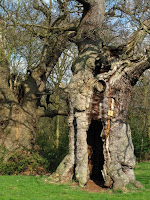 Our destination, Hatfield House, was definitely worth driving to, even though we had a mid-afternoon picnic lunch. Only 30 minutes from home, it feels like a few centuries away. This house has seen so much history. Built in Tudor times by Lord Cecil, the Chancellor, it was home to Elizabeth I for much of her childhood. At the end of the afternoon, we did a walk through the 1,000 acre grounds, past the spot where, in 1558, Elizabeth was given the news that she was now the Queen.
Our destination, Hatfield House, was definitely worth driving to, even though we had a mid-afternoon picnic lunch. Only 30 minutes from home, it feels like a few centuries away. This house has seen so much history. Built in Tudor times by Lord Cecil, the Chancellor, it was home to Elizabeth I for much of her childhood. At the end of the afternoon, we did a walk through the 1,000 acre grounds, past the spot where, in 1558, Elizabeth was given the news that she was now the Queen. The house still has an original feels inside, which doesn't mean it is run down in a 600 year old look, but rather that the Tudor interiors have been carefully preserved and it still looks magnificent today.
The house still has an original feels inside, which doesn't mean it is run down in a 600 year old look, but rather that the Tudor interiors have been carefully preserved and it still looks magnificent today. The house is complimented on three sides by perfectly maintained formal gardens. Only the West Garden is open on weekends, but is a real treat to wander through this expansive garden. The woodland walks have been a mass of daffodils, now finished, but in the woodland beyond the West Gardens, the daffodils are still in perfect condition.
The house is complimented on three sides by perfectly maintained formal gardens. Only the West Garden is open on weekends, but is a real treat to wander through this expansive garden. The woodland walks have been a mass of daffodils, now finished, but in the woodland beyond the West Gardens, the daffodils are still in perfect condition.

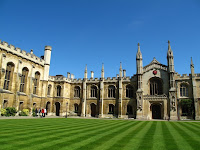 Today was wall to wall sunshine for the whole of England and Wales; a perfect day to enjoy clear blue skies, with not a single vapour trail in sight. (Volcanic ash having grounded every jet.) We drove north to Cambridge, and even the roads seemed quiet. Could Luton and Stansted airports account for so much of the traffic?
Today was wall to wall sunshine for the whole of England and Wales; a perfect day to enjoy clear blue skies, with not a single vapour trail in sight. (Volcanic ash having grounded every jet.) We drove north to Cambridge, and even the roads seemed quiet. Could Luton and Stansted airports account for so much of the traffic?
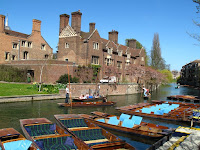
 After parking in Grantchester we set out on the pleasant walk of about 2.5 miles along the Cam into Cambridge. There were plenty of daffodils still flowering along the backs, as we walked past the colleges. Following the Cam took us to the north end of Cambridge, and we were then able to walk back through the town, lunch by the Cam and on to the Botanical Gardens before walking back to Grantchester.
After parking in Grantchester we set out on the pleasant walk of about 2.5 miles along the Cam into Cambridge. There were plenty of daffodils still flowering along the backs, as we walked past the colleges. Following the Cam took us to the north end of Cambridge, and we were then able to walk back through the town, lunch by the Cam and on to the Botanical Gardens before walking back to Grantchester. Grantchester is an attractive small village, made famous by Rupert Brooke in his poem 'The Vicarage'. The Orchard, where he lived before living at The Vicarage, is now an extremely popular tea-room.
Grantchester is an attractive small village, made famous by Rupert Brooke in his poem 'The Vicarage'. The Orchard, where he lived before living at The Vicarage, is now an extremely popular tea-room. We took the scenic back roads on the return trip to London. The first stop was Triplow. Last month they had their annual Daffodil Day, and due to the late seasons this year, there were still daffodils flowering. It must have looked stunning when they were all at their best.
We took the scenic back roads on the return trip to London. The first stop was Triplow. Last month they had their annual Daffodil Day, and due to the late seasons this year, there were still daffodils flowering. It must have looked stunning when they were all at their best.

 Today we joined the annual MG picnic at Arundel Castle. It was a lovely day, and by the end of the morning, the lawns below the castle, were overflowing with MG's.
Today we joined the annual MG picnic at Arundel Castle. It was a lovely day, and by the end of the morning, the lawns below the castle, were overflowing with MG's. Arundel Castle was first built on 1067, and the Keep which is open to the public, is part of that original castle building. The castle proper was rebuilt in Victorian times, after it had lain ruined since the Civil War in the 17th century, and is an amazingly dramatic building, everything is on a generous scale.
Arundel Castle was first built on 1067, and the Keep which is open to the public, is part of that original castle building. The castle proper was rebuilt in Victorian times, after it had lain ruined since the Civil War in the 17th century, and is an amazingly dramatic building, everything is on a generous scale.  Most rooms are rather austere, but the Drawing Room is a blaze of colour and has a welcoming feel. The private chapel is very beautiful, with marble columns, but the most dramatic and appealing room in the house, is the Library. It can hardly be called a room, as it is a series of long rooms, with rich carved mahogany panels, cabinets for books, rich red carpets and curtains. The fireplaces in nooks off to the side of the library made you wish you could spend a winter's day relaxing there with a book. It is said to be the best such private library in England.
Most rooms are rather austere, but the Drawing Room is a blaze of colour and has a welcoming feel. The private chapel is very beautiful, with marble columns, but the most dramatic and appealing room in the house, is the Library. It can hardly be called a room, as it is a series of long rooms, with rich carved mahogany panels, cabinets for books, rich red carpets and curtains. The fireplaces in nooks off to the side of the library made you wish you could spend a winter's day relaxing there with a book. It is said to be the best such private library in England. In the grounds is one of the more unusual churches we have visited in England. Back in Henry 8th's day, it was decreed that the church had to be given to the new Church of England. But the Duke of Norfolk argued that his ancestors were buried there, so as a compromise, the church was divided in two. Half is the Arundel Parish Church of England and used for normal services, the other half can only be entered from the grounds of Arundel Castle, and is still Catholic. It is full of huge and ornate tombs of the Norfolk ancestors.
In the grounds is one of the more unusual churches we have visited in England. Back in Henry 8th's day, it was decreed that the church had to be given to the new Church of England. But the Duke of Norfolk argued that his ancestors were buried there, so as a compromise, the church was divided in two. Half is the Arundel Parish Church of England and used for normal services, the other half can only be entered from the grounds of Arundel Castle, and is still Catholic. It is full of huge and ornate tombs of the Norfolk ancestors.
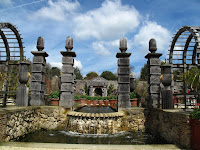
 After a relaxed day admiring the MG's, exploring the castle and the very attractive town, we decided to call into Petworth House on the way back to London. Every room open to the public is covered with works of art by Titan, Turner, Van Dyke, Lely, Cyup among many others, including one by Hieronymus Bosch.
After a relaxed day admiring the MG's, exploring the castle and the very attractive town, we decided to call into Petworth House on the way back to London. Every room open to the public is covered with works of art by Titan, Turner, Van Dyke, Lely, Cyup among many others, including one by Hieronymus Bosch. After Arundel, where the Victorian Castle still seems crisp and new; Petworth would appear very jaded and tired, were it not for the stunning array of artworks. The highlight of the collection is in the Carved Room. Here the entire huge room is filled with old masters in wall to wall carved wooden frames. Half the room was carved by the famous carver Grinling Gibbons, and this was then copied in the remainder of the room. Pride of place in the centre of the long wall, above the fireplace is a painting of Henry 8th. Under all the large paintings are seascapes by Turner, which are almost overlooked in the overall splendour of the room.
After Arundel, where the Victorian Castle still seems crisp and new; Petworth would appear very jaded and tired, were it not for the stunning array of artworks. The highlight of the collection is in the Carved Room. Here the entire huge room is filled with old masters in wall to wall carved wooden frames. Half the room was carved by the famous carver Grinling Gibbons, and this was then copied in the remainder of the room. Pride of place in the centre of the long wall, above the fireplace is a painting of Henry 8th. Under all the large paintings are seascapes by Turner, which are almost overlooked in the overall splendour of the room.
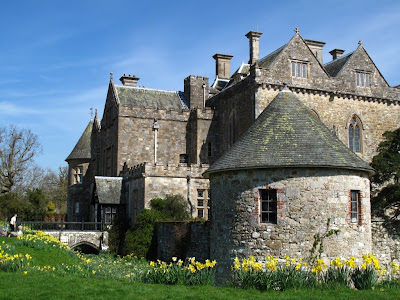
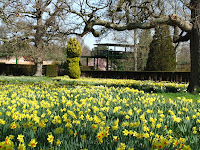 Since Thursday, we have been enjoying the sort of weather everyone would have liked for the Easter break. Fortunately it lasted for the weekend, and we set off for Beaulieu, one of the most visited stately homes in England. The reason for this is that
Since Thursday, we have been enjoying the sort of weather everyone would have liked for the Easter break. Fortunately it lasted for the weekend, and we set off for Beaulieu, one of the most visited stately homes in England. The reason for this is that  Beaulieu's current owner, 83year old Lord Montagu, developed the National Motor Museum in memory of his father, who was an early champion of the motor car, when it was considered smelly, noisy and dangerous.
Beaulieu's current owner, 83year old Lord Montagu, developed the National Motor Museum in memory of his father, who was an early champion of the motor car, when it was considered smelly, noisy and dangerous.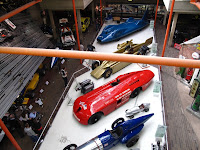 The Motor Museum has an amazing collection of cars, motorbikes and other vintage vehicles. There is also a collection of James Bond vehicles and cars from the TV show Top Gear.
The Motor Museum has an amazing collection of cars, motorbikes and other vintage vehicles. There is also a collection of James Bond vehicles and cars from the TV show Top Gear. A monorail (or vintage bus) takes visitors through the Motor Museum to Beaulieu Palace. This stunning stately Victorian home is modelled on the Abbey nearby, which was dismantled by Henry 8th. While there, we also did a behind the scenes tour of the private wing with a very entertaining Irish guide, dressed as the butler, and learnt a lot of family history. The gardens were full of daffodils, and the Palace was complimented by a moat entirely carpeted with daffodils.
A monorail (or vintage bus) takes visitors through the Motor Museum to Beaulieu Palace. This stunning stately Victorian home is modelled on the Abbey nearby, which was dismantled by Henry 8th. While there, we also did a behind the scenes tour of the private wing with a very entertaining Irish guide, dressed as the butler, and learnt a lot of family history. The gardens were full of daffodils, and the Palace was complimented by a moat entirely carpeted with daffodils. From Beaulieu, we started a circular driving tour, and the next stop was Exbury Gardens. These were developed by Lionel de Rothschild after World War I. The gardens are famous for their azaleas and rhododendrons and although we only saw the early flowering varieties, the daffodil meadow was well worth the visit. In a month's time, the garden will be a blaze of colour.
From Beaulieu, we started a circular driving tour, and the next stop was Exbury Gardens. These were developed by Lionel de Rothschild after World War I. The gardens are famous for their azaleas and rhododendrons and although we only saw the early flowering varieties, the daffodil meadow was well worth the visit. In a month's time, the garden will be a blaze of colour. The circular drive took us through minor roads around the New Forest. Named “new” nearly 1,000 years ago by William the Conqueror, who developed it as his favourite hunting grounds.
The circular drive took us through minor roads around the New Forest. Named “new” nearly 1,000 years ago by William the Conqueror, who developed it as his favourite hunting grounds.



